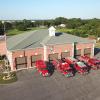In memory of trees lost to development
The Sussex Preservation Coalition used Arbor Day to get across a powerful message. During a ceremony April 29 in Lewes' Stango Park, the grassroots organization planted a white oak in remembrance of all the lost trees in Sussex County due to development.
Bill McAvoy, state botanist, said the county has lost 36,000 acres of forest since 1986, or about 1,000 acres per year.
“We begin by solemnly remembering the trees, forest, woodlands lost to human activity in Sussex County,” said coalition president Jane Gruenebaum. “In remembering the trees, we also honor all creatures above and below ground who rely on trees for shelter, sustenance and protection.
“By destroying trees, we release the carbon stored in them; we destroy needed ecosystems; we leave land anchor less and prone to erosion; we kill nature’s best air and water filters; and, we lose the quiet beauty that soothes our souls. By planting this tree, we pay homage to the many, many ways trees enhance our lives and we promise to work tirelessly to protect our forests and to reforest where possible.”
Jill Hicks, coalition vice president, provided a benediction in honor of trees. “This tree is a symbol of the responsibility given to us to protect life-sustaining forests,” she said.
Gruenebaum said several people joined forces when it became apparent that an umbrella group to bring all grassroots organizations together was needed. The coalition was formed late last year with a mission of education, advocacy and policy.
She said some groups succeeded and then went dormant, while others failed to get off the ground. They learned that groups opposing a major development needed a lot of citizen support. “We realize we need people power to save the forests, trees and wetlands,” she said.
The coalition also announced the start of its Trees = Livable Communities campaign. “We will encourage county council to establish enforceable codes and ordinances needed to protect our trees and we will work with state officials in elevating importance of forest protection and promoting the best means to do so,” Gruenebaum said. “The time is right. The county council has identified forest protection as one of its priority topics. And the trees are disappearing at an alarming rate.”
McAvoy, who has studied the state's flora and fauna for more than three decades, was the featured speaker. He said the No. 1 threat to native and rare species is destruction of forested habitat.
He said Delaware has lost two-thirds of its forests over the centuries and much of what remains has been cut up into fragmented woodlands.
However, he said, it's important to save the fragmented sections, especially in coastal areas, because they provide critical habitat for migrating song birds.
“With the forest loss, Delaware is losing its biodiversity and natural heritage. Conservation is a challenge. You need lots of partners,” McAvoy said.
Several organizations, including Sierra Club, Delaware Chapter and Teach a Person to Fish Society took part in the event.
The coalition will meet from 3 to 4:30 p.m., Tuesday, May 9, at the Lewes library, 111 Adams Ave. Christophe Tulou, Delaware Center for the Inland Bays executive director, will provide an update on the health of the Inland Bays. Meetings are in person and virtual.
Go to sussexpreservationcoalition.org for more information.



























































